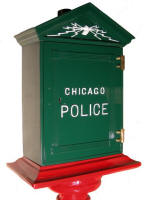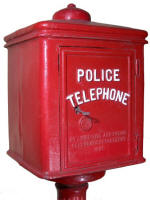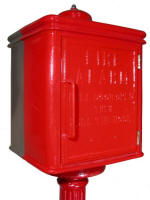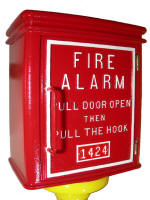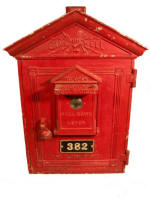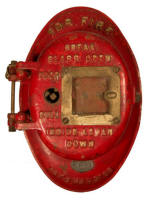Fire & PoliceAlarm Boxes |
|
Fire alarms have been around for centuries. Many of these alarms were very primitive and often times ineffective. The need for improved fire alarms was very apparent in the early days of large cities, dating back to the late 1700's. Often times what started as a small house fire, could often times lead to mass devastation within a large city. This, due to the lack of decent alarm systems. One of the most flagrant examples of this occurred in New Orleans, on Good Friday, March 21, 1788. As told by Paul Ditzel in his book, Fire Alarm!, "the usual method for sounding the alarm was the same as that in many communities: ringing church bells. But the Capuchin priests, out of reverence for the holy day, refused to allow the bells to be tolled." Nearly 900 buildings were destroyed before any firefighting was orchestrated. This was America's worst fire at the time. According to Ditzel, "Methods for sounding fire alarms in colonial times to the start of the phenomenal growth of American cities in the mid-19th century were a grab bag of sometimes mocking, sometimes incredibly naive approaches: blowing fox-calling horns and conch shells, banging of drums, swinging metal bars in a circular motion while striking the side of metal triangles or banging on hoops." The need for a better alarm system was extremely apparent to Dr. William Francis Channing, a physician who actually never practiced medicine, but developed the first fire alarm box and telegraphic system for transmitting alarms. The box he originally developed was a Fire Telegraph Alarm. Simply put, the box would send a telegraphic signal to the fire house, alerting the firemen of the fire and where the signal came from. Inside each box was a crank, turning the crank would turn a wheel with a certain number to teeth. These teeth would correspond with the location of the box, each box having a unique set of teeth. "The telegraphic circuit would open and close by the grouped number of teeth cut into the wheel. Thus, the box number (i.e. its location) could be transmitted to the receiving station" (Gurka). Click here for an image and description of its workings. Boston was the first city to have a system of these boxes installed. Starting with just two boxes in 1848, and then three years later in 1851, the city dedicated $10,000 for an entire system. While Chaning was credited with coming up with the design, it was his partner Moses Gerrish Farmer, who pioneered the development and maintenance of the telegraph systems. Obviously, without an actual telegraph system, invented by Samuel M. Moris in 1835, this system would not have been possible. Notably, Berlin, Germany would have a system of 46 stations of similar fashion installed in 1851 as well. Chaning and Farmer sold the rights to their system to John Nelson Gamewell in 1855 for $30,000. His company would go on to be the exclusive manufacture and installer of these systems until alarm boxes were no longer used. Gamewell was indicted by the Federal Grand Jury in 1946. As with any 'first,' there were many problems, which led to new more sophisticated alarm boxes. Eventually leading up to the 'Call Box,' which rather than a telegraph system, it had an actual phone to call in an emergency to fire or police. Antique Warehouse currently has 18 alarm and call boxes in its collection. Many of them are from the St. Louis area, which had its first alarm system installed by Gamewell in 1856 (Roncallo). Click here to find out more information about Fire Alarm Boxes in the City of Saint Louis. |
Ditzel, Paul Fire Alarm!. Conway Enterprises, New Albany, IN. 1990. Gurka, Andrew. Firefighting Collectables. L-W Book Sales, Gas City, IN. 1994. Roncallo, Paul C. History of the Fire Alarm and Police Telegraph. M.T. Publishing, Evansville, IN. 2005. Click here to view all of our Fire & Police Reference Books |
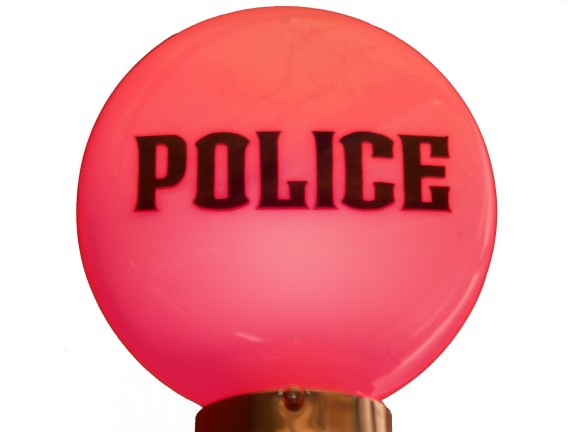 |
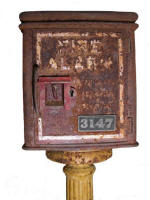 |
|
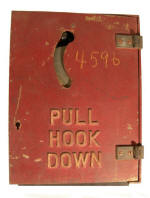 |
||
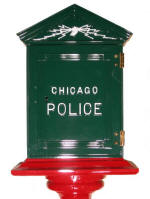 |
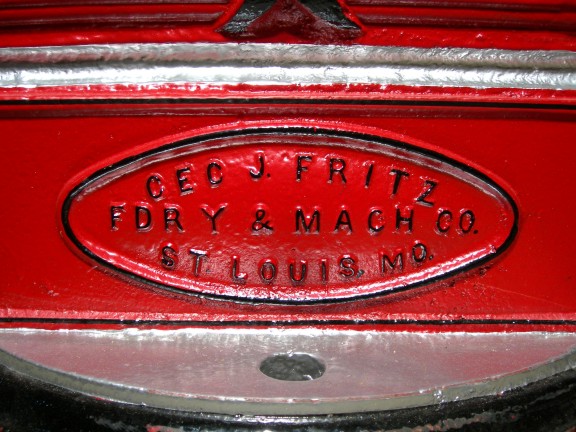 |
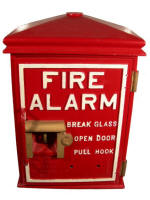 |
